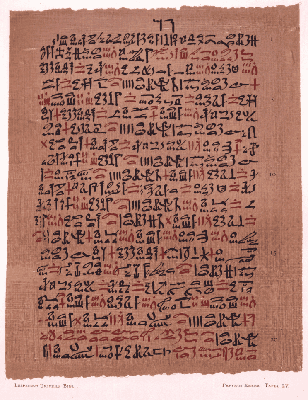The manuscript website I chose to evaluate was "Manuscripts & Manuscript Copying Timeline". I chose this website because it has a lot of wonderful information and so many different manuscripts to look at.
My first impression of the ancient works on this webpage was nothing more than being in awe. I have always found Egypt to be an interesting place and to see some of the manuscripts that are there, being uncovered and translated has always sparked my interests. I find it so amazing that even way back in the early days people used pictures to tell their stories. As far as design elements go, I assumed that the manuscripts would not really have much design in them, but I was quite intrigued as I looked further to see that there are actually some versions of design in the earlier manuscripts.
- Contrast
- Contrast was used many times. They did not have as many colors as we do, but there were many manuscripts that used black for some words/pictures and red for other. An example is The Oldest Surgical Treatise Circa 1,600 BCE which discusses the earliest of surgical procedures. It has red text as well as black text.
- Repetition:
- When I looked at some of the early Egyptian manuscripts found, they use a lot of symbols for their words. These symbols would be repeated over and over. there are also a lot of repeated symbols on other manuscripts that I viewed. I realize that these symbols stand for certain words and are repeated to give a understanding of what is being discussed.
- Alignment:
- Many of the manuscripts use the element of alignment. In fact, for the most part the manuscripts that I viewed were each using this element. The pictures, or old script always seemed to be aligned. I do not know if they were being read left to right, right to left or top to bottom, but they definitely were in alignment. I never thought of it before, but studying these elements really made it noticeable for me.
- Proximity:
- These manuscripts almost always used the elements of proximity. Every word went with the next. Every symbol was used in a group with like symbols. There was no confusions with what went together and what did not belong.
The
authors/artists gave many examples of what the manuscripts meant and how
they are translated. They also gave us links to click on that go
further into detail about the manuscript, the author of the manuscript
and other things that were discussed in the manuscript. I was able to
learn a deeper meaning about how these manuscripts were discovered,
where they were discovered, who translated it, and what was being said
in the manuscripts.
Norman, J. (2012). Manuscripts & Manuscript
Copying Timeline. Retrieved July 7, 2012, from Jerry Norman's From Cave
Painting to the Internet. Chronological and Thematic Studies on the History of
Information and Media:
http://www.historyofinformation.com/expanded.php?category=Manuscripts+%26+Manuscript+Copying

No comments:
Post a Comment